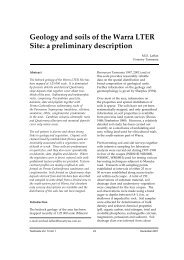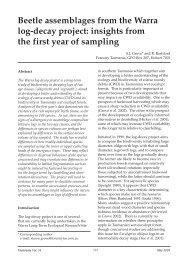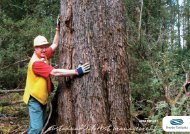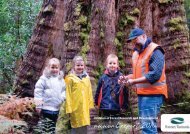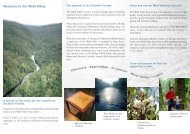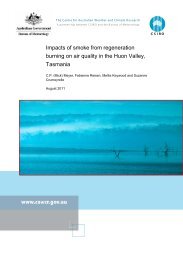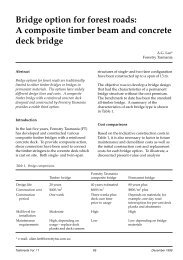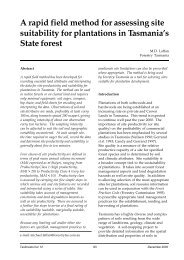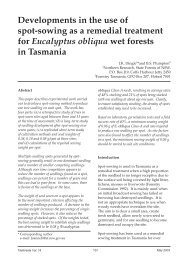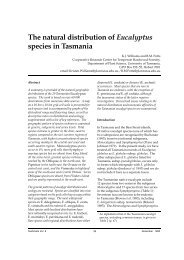annual report 2011 - Forestry Tasmania
annual report 2011 - Forestry Tasmania
annual report 2011 - Forestry Tasmania
You also want an ePaper? Increase the reach of your titles
YUMPU automatically turns print PDFs into web optimized ePapers that Google loves.
Native Forests - Key research and development projects (continued)<br />
Sustainability Objective FT Staff and<br />
Collaborators<br />
Project name and aims 2010-11 Progress<br />
2. Sustaining jobs for current and future generations<br />
2.3.1 Eucalypt forests<br />
Ensure an ongoing long term<br />
supply of the highest quality<br />
eucalypt timbers from native<br />
forests.<br />
M Neyland<br />
L Clark<br />
T Osborn<br />
Rationalisation, measurement and<br />
maintenance of established thinning trials<br />
To rationalise the existing thinning trials, to<br />
commence data analysis using existing data sets,<br />
and to determine the most efficient program of<br />
monitoring for the next few years.<br />
Progressed bringing existing native forests data sets into corporate data<br />
bases.<br />
M Neyland<br />
D Mannes<br />
S Whiteley<br />
District Staff<br />
Operational plan and business case for<br />
expanded program of ‘thinning’<br />
To identify opportunities for intensive forest<br />
management on a sound economic and<br />
silvicultural basis. The aim is to produce more<br />
peeler logs now and more high quality sawlog in<br />
the future.<br />
LiDAR data for Bass district was analysed and field checked. Developed a<br />
‘thinnability index’ based on height and canopy cover from the LiDAR data<br />
together with information from PI (regrowth/regen).<br />
M Neyland<br />
L Edwards<br />
D McElwee<br />
R Musk<br />
District Staff<br />
Sowing trials<br />
To examine the influence of sowing rate on<br />
seedling establishment rate. The aim is to<br />
determine whether higher seedling densities can<br />
be achieved through sowing at higher rates.<br />
A replicated randomised block designed trial has been established at three<br />
sites in southern <strong>Tasmania</strong>, where the blocks have been sown at one of<br />
four different sowing rates. In addition, operational level trials have been<br />
established in 5 coupes throughout the state, where a randomly selected<br />
section of the coupe has been sown at double the normal sowing rate.<br />
M Neyland<br />
L Clark<br />
High altitude eucalypt forests<br />
To provide silvicultural advice and to promote<br />
good silvicultural practice in high altitude forests.<br />
The UAT procedure has become widely accepted as a useful tool for<br />
planning and monitoring the harvesting of high/dry E. delegatensis forest.<br />
Pre-logging assessments have declined recently due to a lack of staff.<br />
Progressive harvesting assessments continue to be useful<br />
In 2006-07, 1969 ha were treated and 94% met the standard.<br />
In 2007-08, 3078 ha were treated and 93% met the standard.<br />
In 2008-09, 3575 ha were treated and 93% met the standard.<br />
In 2009-10, 2653 ha were treated and 97% met the standard.<br />
In 2010-11, 2560 ha were treated and 86% met the standard.<br />
Two coupes failed to meet the required minimum damage level and<br />
assessment was not completed on two coupes.<br />
28




